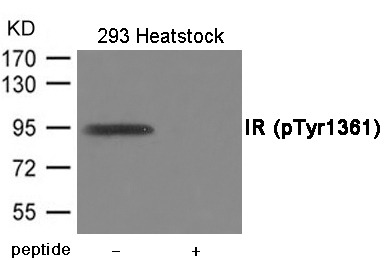购物车
全部删除  您的购物车当前为空
您的购物车当前为空
别名 p-Insulin Receptor (Y1361), p-Insulin Receptor (Tyr1361), Insulin Receptor (p-Y1361), Insulin Receptor (p-Tyr1361)
Anti-Phospho-Insulin Receptor (Tyr1361) Polyclonal Antibody 是一种 Rabbit 抗体,靶向 Phospho-Insulin Receptor (Tyr1361)。Anti-Phospho-Insulin Receptor (Tyr1361) Polyclonal Antibody 可用于 WB。
Anti-Phospho-Insulin Receptor (Tyr1361) Polyclonal Antibody 是一种 Rabbit 抗体,靶向 Phospho-Insulin Receptor (Tyr1361)。Anti-Phospho-Insulin Receptor (Tyr1361) Polyclonal Antibody 可用于 WB。
| 规格 | 价格 | 库存 | 数量 |
|---|---|---|---|
| 50 μL | ¥ 1,485 | 5日内发货 | |
| 100 μL | ¥ 2,245 | 5日内发货 |
| 产品描述 | Anti-Phospho-Insulin Receptor (Tyr1361) Polyclonal Antibody is a Rabbit antibody targeting Phospho-Insulin Receptor (Tyr1361). Anti-Phospho-Insulin Receptor (Tyr1361) Polyclonal Antibody can be used in WB. |
| 别名 | p-Insulin Receptor (Y1361), p-Insulin Receptor (Tyr1361), Insulin Receptor (p-Y1361), Insulin Receptor (p-Tyr1361) |
| Ig Type | IgG |
| 交叉反应 | Human,Mouse,Rat |
| 验证活性 | 1. Western blot analysis of extracts from 293 cells treated with Heatstock using IR (Phospho-Tyr1361) Antibody TMAC-02206. The lane on the right is treated with the antigen-specific peptide.  |
| 应用 | WB |
| 抗体种类 | Polyclonal |
| 宿主来源 | Rabbit |
| 构建方式 | Polyclonal Antibody |
| 纯化方式 | Antibodies were produced by immunizing rabbits with synthetic phosphopeptide and KLH conjugates. Antibodies were purified by affinity-chromatography using epitope-specific phosphopeptide. Non-phospho specific antibodies were removed by chromatogramphy using non-phosphopeptide. |
| 性状 | Liquid |
| 缓冲液 | Supplied at 1.0mg/mL in phosphate buffered saline (without Mg2+ and Ca2+), pH 7.4, 150mM NaCl, 0.02% sodium azide and 50% glycerol. |
| 研究背景 | Receptor tyrosine kinase which mediates the pleiotropic actions of insulin. Binding of insulin leads to phosphorylation of several intracellular substrates, including, insulin receptor substrates (IRS1, 2, 3, 4), SHC, GAB1, CBL and other signaling intermediates. Each of these phosphorylated proteins serve as docking proteins for other signaling proteins that contain Src-homology-2 domains (SH2 domain) that specifically recognize different phosphotyrosines residues, including the p85 regulatory subunit of PI3K and SHP2. Phosphorylation of IRSs proteins lead to the activation of two main signaling pathways: the PI3K-AKT/PKB pathway, which is responsible for most of the metabolic actions of insulin, and the Ras-MAPK pathway, which regulates expression of some genes and cooperates with the PI3K pathway to control cell growth and differentiation. Binding of the SH2 domains of PI3K to phosphotyrosines on IRS1 leads to the activation of PI3K and the generation of phosphatidylinositol-(3, 4, 5)-triphosphate (PIP3), a lipid second messenger, which activates several PIP3-dependent serine/threonine kinases, such as PDPK1 and subsequently AKT/PKB. The net effect of this pathway is to produce a translocation of the glucose transporter SLC2A4/GLUT4 from cytoplasmic vesicles to the cell membrane to facilitate glucose transport. Moreover, upon insulin stimulation, activated AKT/PKB is responsible for: apoptotic effect of insulin by inducing phosphorylation of BAD; regulates the expression of gluconeogenic and lipogenic enzymes by controlling the activity of the winged helix or forkhead (FOX) class of transcription factors. Another pathway regulated by PI3K-AKT/PKB activation is mTORC1 signaling pathway which regulates cell growth and metabolism and integrates signals from insulin. AKT mediates insulin-stimulated protein synthesis by phosphorylating TSC2 thereby activating mTORC1 pathway. The Ras/RAF/MAP2K/MAPK pathway is mainly involved in mediating cell growth, survival and cellular differentiation of insulin. Phosphorylated IRS1 recruits GRB2/SOS complex, which triggers the activation of the Ras/RAF/MAP2K/MAPK pathway. In addition to binding insulin, the insulin receptor can bind insulin-like growth factors (IGFI and IGFII). Isoform Short has a higher affinity for IGFII binding. When present in a hybrid receptor with IGF1R, binds IGF1. Ref.40 shows that hybrid receptors composed of IGF1R and INSR isoform Long are activated with a high affinity by IGF1, with low affinity by IGF2 and not significantly activated by insulin, and that hybrid receptors composed of IGF1R and INSR isoform Short are activated by IGF1, IGF2 and insulin. In contrast, Ref.46 shows that hybrid receptors composed of IGF1R and INSR isoform Long and hybrid receptors composed of IGF1R and INSR isoform Short have similar binding characteristics, both bind IGF1 and have a low affinity for insulin. |
| 偶联 | Unconjugated |
| 其他可选修饰符 | Phospho |
| 免疫原 | Peptide sequence around phosphorylation site of Tyrosine 1361 (I-P-Y(p)-T-H) derived from Human IR |
| 抗原种属 | human |
| Uniprot ID |
| 分子量 | Actual: 95 kDa. |
| 储存方式 | Store at -20°C or -80°C for 12 months. Avoid repeated freeze-thaw cycles. |
| 运输方式 | Shipping with blue ice. |
评论内容